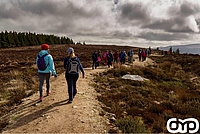Watchable Wildlife
Red Grouse / Cearc Fhraoigh / Lagopus lagopus
Did you know?
- Known as cearc fhraoigh as Gaeilge which means bird of heather
- Smaller than pheasants and have a rounded tail
- Ling heather Calluna vulgaris is crucial in the life cycle of red grouse
- They feed on young heather shoots, flowers and seed. Berries such as fraocháns or bilberry and some insects are eaten.
- Red grouse are a red listed species, meaning it has a high conservation concern
- Nest on the ground
- Takes off explosively and flies with a series of rapid wing beats followed by a short glide.
What to watch for:
Size: Smaller than a pheasant, rounded body, wings and tail.
Coloration:
- Males have a deep red-brown plumage with paler underwings, white feathered legs and a bright red comb above the eye. They look almost black from a distance. The hen red grouse has yellower plumage
Where to watch:
- Bird of heath, raised and blanket bog
When to watch:
- All year round, but especially in the breeding season when the birds are more conspicuous
Listen for:
- Calls are distinctive accelerating series of loud nasal calls ending in a trill.
Sites:
Tibradden heathland
- Recreation
- Archaeology
Recreation Sites in the Dublin Mountains
- 5. Kilmashogue
- 6. Ticknock
- 7. Carrickgollogan
- 8. Barnaslingan
Archaeology Sites in the Dublin Mountains
- 1. Slievethoul
- 2. Lugg Woods
- 3. Seahan
- 4. Hell Fire Club
- 5. Massy's Wood
- 6. Tibradden
- 7. Kilmashogue
- 8. Ticknock
- 9. Ballyedmonduff
- 10. Rathmichael Wood







